Anna Müller-Lincke (1869-1935) was a German soubrette and stage and screen actress. Earning herself the sobriquet 'Königin des Humors' (Queen of Humour), she performed on stage in Berlin and later conducted successful tours of Europe and the Americas. For a while, she had her own film company, Anna Müller-Lincke-Film, and she was popular enough to start a whole series of comedies with her character Anna.
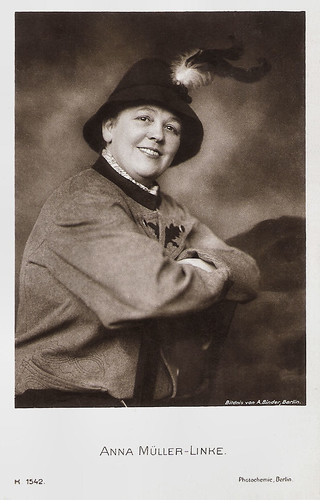
German postcard by Photochemie, Berlin, no. K. 1542. Photo: Alex Binder, Berlin.
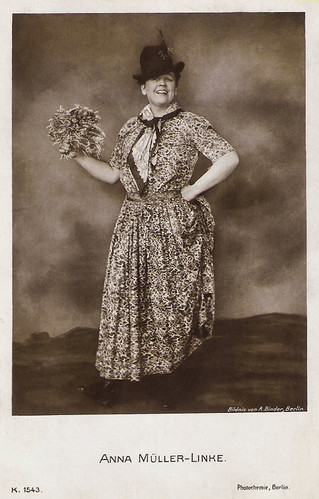
German postcard by Photochemie, Berlin, no. K. 1543. Photo: Alex Binder, Berlin.
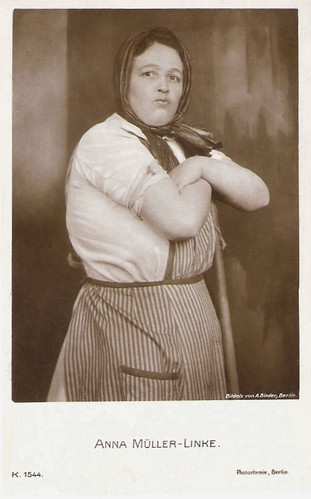
German postcard by Photochemie, Berlin, no. K. 1544. Photo: Alex Binder, Berlin.
Anna Müller-Lincke was born Anna Marie Louise Waldmüller (according to some sources: Müller) in Berlin in 1869. Already at the age of four, she made her stage debut at the Nationaltheater in Berlin. She performed with her sister Ida, who was seven years her senior,
As a teenager, she had singing lessons from the opera singer Mathilde Mallinger. Anna soon became a well-known soubrette and also stage actress. Only 16, she played in the Ostend Theater in Berlin in the Gross-Frankfurter Straße, later known as the Rose Theater.
At the Ostend Theater, she met in 1885 the then 19-year-old bassoonist Paul Lincke. In 1893 (some sources say 1886), they married and from then on Anna acted under the name Anna Müller-Lincke. Paul Lincke later celebrated triumphs as an operetta composer and went down in history as the 'father of the Berlin operetta'. In 1898 (some sources say 1901) the couple divorced again. Reportedly, the turbulent separation was the result of an affair by Paul Lincke, when he worked in Paris as the chef of the orchestra at the Folies Bergères.
Anna Müller-Lincke had a brilliant stage career. She performed at the Victoria Theater, the Belle Alliance Theater, the Central Theater, the Adolf Ernst Theater and seven years at the prestigious Metropol Theater and Lessing Theater. Performances took her to France, Holland, Denmark, Russia and North and South America.
Already in 1907, Anna Müller-Lincke performed as singer in two early sound films (Tonbilder) for the Deutsche Bioskop: Abends nach Neune: Duett aus Durchlaucht Radieschen. Nr. 11, and Roland und Viktoria: Duett aus "Neuestes! Allerneuestes!". Nr. 10, both sung with Leonhard Haskel. It was then a daring step to try to gain a foothold in the disapproved-of film business.
In 1910, the courageous Müller-Lincke appeared for Messter-Film in her first silent fiction film, Bundrika, die Negerköchin/Bundrika the Negro Cook, but it was only from 1913 that she had a steady career in German silent cinema. Initially, she appeared in hearty roles (cooks, maids, resolute widows), latterly as dowagers and little old ladies.
In 1913, she appeared in such films as Zwei Tage im Paradies/Tow days in paradise (Danny Kaden, 1913), Die Firma heiratet/The Firm Gets Married (Carl Wilhelm, 1913) starring Ernst Lubitsch, and the hit comedy Wo ist Coletti/Where Is Coletti? (Max Mack 1913) with Hans Junkermann.
During the First World War, she appeared in Die Marketenderin/The sutler (Carl Wilhelm, 1914), Hans und Hanni/Hans and Hanni (Max Mack, 1914) with Hanni Weisse, Frau Annas Pilgerfahrt/Mrs. Anna's pilgrimage (Carl Wilhelm, 1915), Musketier Kaczmarek/Musketeer Kaczmarek (Carl Froehlich, 1915), Zofenstreiche/Maid sweep (Hubert Moest, 1915) with Hedda Vernon, Hampels Abenteuer/Hampel's Adventures (Richard Oswald, 1915), and Vom Regen in die Traufe/From the rain in the eaves (Emil Albes, Einar Bruun, 1917).

German postcard by Photochemie, Berlin, no. K. 1545. Photo: A. Binder, Berlin.
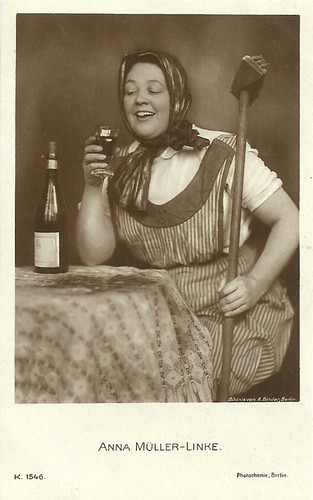
German postcard by Photochemie, Berlin, no. K. 1546. Photo: A. Binder, Berlin.
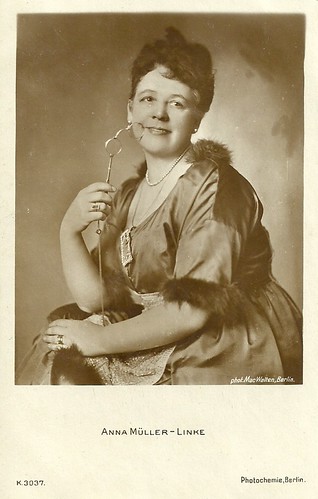
German postcard by Photochemie, Berlin, no. K. 3837. Photo: MacWalten, Berlin.
In 1917, Anna Müller-Lincke founded her own company Anna Müller-Lincke-Film, for which she produced Die linkische Anna (1917). Though her company was short lived Lincke was popular enough to start a whole series with her character Anna: Rechtsanwalt Anna/Lawyer Anna (1917), Anna Müller-Lincke kandidiert/Anna Müller-Lincke is running (Werner Sinn, 1919), Anna mit'n Flimmerfimmel/Anna with the flicker fool (Charley Mettinger, 1919).
In 1919-1920, Lincke was productive with four to five some films per year. While Lincke worked for all kinds of companies, in 1919-1920 she did various films for DLG (Deutsche Lichtbild-Gesellschaft) such as Margots Freier/Margot's suitor (Hans Werckmeister, 1919).
By 1921 the vogue of the Anna-comedies was over and Lincke had to be content with supporting parts in dramas and comedies. After a gap in 1922-1923, she returned in commercials in 1924 and supporting parts in fiction from 1925, such as Sündenbabel/Den of Iniquity (Constantin J. David, 1925) with Reinhold Schünzel, Was eine Frau im Frühling träumt/What a Woman Dreams of in Springtime (Curt Blachnitzky, 1928-1929), Kehre zurück! Alles vergeben!/Come Back, All Is Forgiven (Erich Schönfelder, 1929) with Dina Gralla, and Lumpenball/Rags ball (Carl Heinz Wolff, 1930).
Thanks to her song and stage career, Anna Müller-Lincke easily switched to sound film. She could be seen in such early sound films as Die große Sehnsucht/The Great Longing (István Székely, 1930) with Theodor Loos and Camilla Horn, Der wahre Jakob/The true Jacob (Hans Steinhoff, 1930-31) – in which Müller-Lincke even had the lead - and the Alfred Döblin adaptation Berlin–Alexanderplatz (Phil Jutzi, 1931) with Heinrich George as Franz Biberkopf.
Her repertory ranged from a bit part in the communist film Kuhle Wampe oder Wem gehört die Welt?/To Whom Does the World Belong? (Slatan Dudow, 1932) with Hertha Thiele, to another bit part in the fascist film Hitlerjunge Quex/Our Flag Leads Us Forward (Hans Steinhoff, 1933) with Heinrich George.
In addition to various, uncredited bit parts in the early 1930s, more substantial parts followed for Müller-Lincke in e.g. Die blonde Nachtigall/The Blonde Nightingale (Johannes Meyer, 1930) and the shorts Der Herr von nebenan/The gentleman next door (Rolf Randolf, 1933), Carlos schönste Abenteuer/Carlo's most beautiful adventure (Phil Jutzi, 1934) with Carlo Aldini, and Ferner liefen/Further ran (Phil Jutzi, 1934).
Anna Müller-Lincke died in Berlin in 1935. She was 66, and she had worked on till shortly before her death.
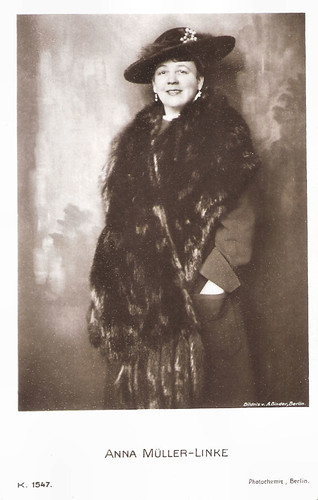
German postcard by Photochemie, Berlin, no. K. 1547. Photo: Alex Binder, Berlin.

German postcard by NPG, no. 431. Photo: Alex Binder, Berlin.
Sources: Stephanie D'heil (Steffi-Line - German), Filmportal.de, Wikipedia (German and English) and IMDb.

German postcard by Photochemie, Berlin, no. K. 1542. Photo: Alex Binder, Berlin.

German postcard by Photochemie, Berlin, no. K. 1543. Photo: Alex Binder, Berlin.

German postcard by Photochemie, Berlin, no. K. 1544. Photo: Alex Binder, Berlin.
A well-known soubrette
Anna Müller-Lincke was born Anna Marie Louise Waldmüller (according to some sources: Müller) in Berlin in 1869. Already at the age of four, she made her stage debut at the Nationaltheater in Berlin. She performed with her sister Ida, who was seven years her senior,
As a teenager, she had singing lessons from the opera singer Mathilde Mallinger. Anna soon became a well-known soubrette and also stage actress. Only 16, she played in the Ostend Theater in Berlin in the Gross-Frankfurter Straße, later known as the Rose Theater.
At the Ostend Theater, she met in 1885 the then 19-year-old bassoonist Paul Lincke. In 1893 (some sources say 1886), they married and from then on Anna acted under the name Anna Müller-Lincke. Paul Lincke later celebrated triumphs as an operetta composer and went down in history as the 'father of the Berlin operetta'. In 1898 (some sources say 1901) the couple divorced again. Reportedly, the turbulent separation was the result of an affair by Paul Lincke, when he worked in Paris as the chef of the orchestra at the Folies Bergères.
Anna Müller-Lincke had a brilliant stage career. She performed at the Victoria Theater, the Belle Alliance Theater, the Central Theater, the Adolf Ernst Theater and seven years at the prestigious Metropol Theater and Lessing Theater. Performances took her to France, Holland, Denmark, Russia and North and South America.
Already in 1907, Anna Müller-Lincke performed as singer in two early sound films (Tonbilder) for the Deutsche Bioskop: Abends nach Neune: Duett aus Durchlaucht Radieschen. Nr. 11, and Roland und Viktoria: Duett aus "Neuestes! Allerneuestes!". Nr. 10, both sung with Leonhard Haskel. It was then a daring step to try to gain a foothold in the disapproved-of film business.
In 1910, the courageous Müller-Lincke appeared for Messter-Film in her first silent fiction film, Bundrika, die Negerköchin/Bundrika the Negro Cook, but it was only from 1913 that she had a steady career in German silent cinema. Initially, she appeared in hearty roles (cooks, maids, resolute widows), latterly as dowagers and little old ladies.
In 1913, she appeared in such films as Zwei Tage im Paradies/Tow days in paradise (Danny Kaden, 1913), Die Firma heiratet/The Firm Gets Married (Carl Wilhelm, 1913) starring Ernst Lubitsch, and the hit comedy Wo ist Coletti/Where Is Coletti? (Max Mack 1913) with Hans Junkermann.
During the First World War, she appeared in Die Marketenderin/The sutler (Carl Wilhelm, 1914), Hans und Hanni/Hans and Hanni (Max Mack, 1914) with Hanni Weisse, Frau Annas Pilgerfahrt/Mrs. Anna's pilgrimage (Carl Wilhelm, 1915), Musketier Kaczmarek/Musketeer Kaczmarek (Carl Froehlich, 1915), Zofenstreiche/Maid sweep (Hubert Moest, 1915) with Hedda Vernon, Hampels Abenteuer/Hampel's Adventures (Richard Oswald, 1915), and Vom Regen in die Traufe/From the rain in the eaves (Emil Albes, Einar Bruun, 1917).

German postcard by Photochemie, Berlin, no. K. 1545. Photo: A. Binder, Berlin.

German postcard by Photochemie, Berlin, no. K. 1546. Photo: A. Binder, Berlin.

German postcard by Photochemie, Berlin, no. K. 3837. Photo: MacWalten, Berlin.
Anna-comedies
In 1917, Anna Müller-Lincke founded her own company Anna Müller-Lincke-Film, for which she produced Die linkische Anna (1917). Though her company was short lived Lincke was popular enough to start a whole series with her character Anna: Rechtsanwalt Anna/Lawyer Anna (1917), Anna Müller-Lincke kandidiert/Anna Müller-Lincke is running (Werner Sinn, 1919), Anna mit'n Flimmerfimmel/Anna with the flicker fool (Charley Mettinger, 1919).
In 1919-1920, Lincke was productive with four to five some films per year. While Lincke worked for all kinds of companies, in 1919-1920 she did various films for DLG (Deutsche Lichtbild-Gesellschaft) such as Margots Freier/Margot's suitor (Hans Werckmeister, 1919).
By 1921 the vogue of the Anna-comedies was over and Lincke had to be content with supporting parts in dramas and comedies. After a gap in 1922-1923, she returned in commercials in 1924 and supporting parts in fiction from 1925, such as Sündenbabel/Den of Iniquity (Constantin J. David, 1925) with Reinhold Schünzel, Was eine Frau im Frühling träumt/What a Woman Dreams of in Springtime (Curt Blachnitzky, 1928-1929), Kehre zurück! Alles vergeben!/Come Back, All Is Forgiven (Erich Schönfelder, 1929) with Dina Gralla, and Lumpenball/Rags ball (Carl Heinz Wolff, 1930).
Thanks to her song and stage career, Anna Müller-Lincke easily switched to sound film. She could be seen in such early sound films as Die große Sehnsucht/The Great Longing (István Székely, 1930) with Theodor Loos and Camilla Horn, Der wahre Jakob/The true Jacob (Hans Steinhoff, 1930-31) – in which Müller-Lincke even had the lead - and the Alfred Döblin adaptation Berlin–Alexanderplatz (Phil Jutzi, 1931) with Heinrich George as Franz Biberkopf.
Her repertory ranged from a bit part in the communist film Kuhle Wampe oder Wem gehört die Welt?/To Whom Does the World Belong? (Slatan Dudow, 1932) with Hertha Thiele, to another bit part in the fascist film Hitlerjunge Quex/Our Flag Leads Us Forward (Hans Steinhoff, 1933) with Heinrich George.
In addition to various, uncredited bit parts in the early 1930s, more substantial parts followed for Müller-Lincke in e.g. Die blonde Nachtigall/The Blonde Nightingale (Johannes Meyer, 1930) and the shorts Der Herr von nebenan/The gentleman next door (Rolf Randolf, 1933), Carlos schönste Abenteuer/Carlo's most beautiful adventure (Phil Jutzi, 1934) with Carlo Aldini, and Ferner liefen/Further ran (Phil Jutzi, 1934).
Anna Müller-Lincke died in Berlin in 1935. She was 66, and she had worked on till shortly before her death.

German postcard by Photochemie, Berlin, no. K. 1547. Photo: Alex Binder, Berlin.

German postcard by NPG, no. 431. Photo: Alex Binder, Berlin.
Sources: Stephanie D'heil (Steffi-Line - German), Filmportal.de, Wikipedia (German and English) and IMDb.
No comments:
Post a Comment